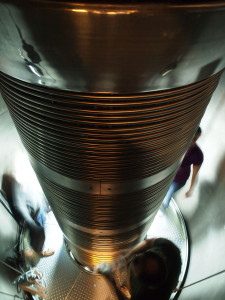 I can remember my first day at Surrey very vividly, it rained. In fact it rained everyday for 6 ½ weeks. At the time I wasn’t really sure where I wanted to be after the 4 years, but somewhere dry was at the top of my list. As it turns out the University of Surrey was actually a great place to be, not only did I enjoy my time whilst there, the contacts and collaborations of the Physics department saw me not only working at CERN for a year as part of my MPhys research, but also got me in contact with many other institutions where further positions were possible. So, after getting my MPhys degree, I found myself in the Nuclear Science Laboratory at the University of Notre Dame in the US, where after my PhD and Postdoc, I am now transitioning into a research faculty position. The University itself is a unique place, an American University founded by a French priest, with the nickname “The Fighting Irish”. However, the lab finds itself at the forefront of low-energy nuclear astrophysics research, both experimental and theoretical.
I can remember my first day at Surrey very vividly, it rained. In fact it rained everyday for 6 ½ weeks. At the time I wasn’t really sure where I wanted to be after the 4 years, but somewhere dry was at the top of my list. As it turns out the University of Surrey was actually a great place to be, not only did I enjoy my time whilst there, the contacts and collaborations of the Physics department saw me not only working at CERN for a year as part of my MPhys research, but also got me in contact with many other institutions where further positions were possible. So, after getting my MPhys degree, I found myself in the Nuclear Science Laboratory at the University of Notre Dame in the US, where after my PhD and Postdoc, I am now transitioning into a research faculty position. The University itself is a unique place, an American University founded by a French priest, with the nickname “The Fighting Irish”. However, the lab finds itself at the forefront of low-energy nuclear astrophysics research, both experimental and theoretical.
My research has covered a wide range of experimental techniques associated with the study of nuclear reaction mechanisms in stellar environments. The dry explanation would be; we measure and try to quantify the rate at which key reactions take place in stellar environments, leading to a better understanding of not only energy production, but also how the elements are created. However in my opinion, a better way to describe my day-to-day research is that I get to play with really cool equipment and experimental set-ups that I have thought-up and built for an exact purpose. This also involves the operation and manipulation of 3 accelerators up to 10 million volts. The amazing thing about research in such a hands-on environment is you get to take part in all aspects of many diverse projects. From measuring the rates of reactions that take place during explosive nucleosynthesis, to element identification of works of art thought to be fakes. I am also currently involved in a project that would see the creation of an enormous underground multi-user laboratory due to be built in an abandoned gold mine. The Deep Underground Science and Engineering Laboratory (DUSEL) project would see all fields of science and technology come together in one lab, with my particular focus on the installation of a nuclear accelerator lab about half way down the levels of the mine, in an attempt to reduce cosmic ray induced background.
It was not only the training and education I received at Surrey that was invaluable, it was also the opportunities afforded to me by the world wide recognition and connections the Physics department has. It is this basis that has made the transition possible into both new areas of research and to the forefront of modern experimental techniques.
